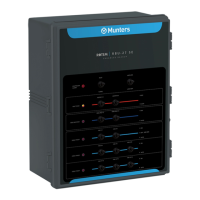25
8. Appendix B: Electrical Grounding
o Electrical equipment can be destroyed or slowly damaged by voltage spikes, lightning hits, etc.
o Proper electrical grounding in combination with the RBU-27 SE internal protections is essential for system
protection, reduction of systemic damage and prolongs its lifetime.
o Grounding reduces the risk of human injury.
o Proper grounding provides an easy path for an electrical current to return to its source.
o A grounding system should tie all non-current carrying conductors to earth ground (0 volts).
o The grounding system should present a minimum resistance to current flow.
o Make sure all items used are in proper condition. For example: a corroded wire clamp attaching a ground
wire to a ground rod might add 100 Ω or more resistance to a system.
o Less than 25 Ω is considered good grounding.
8.1 Ground Rods
Ground rods are used to efficiently connect the system to earth where a current may dissipate in the soil.
o Material: Ground rods should be copper clad or galvanized steel.
o Diameter: Minimum 5/8”, preferably 3/4”. The larger the rod diameter, the lower its resistance to current flow.
o Length: Minimum 2.5 meters (8 feet), preferably 3-meter (10-foot). A longer ground rod will reach a soil with
higher moisture content. Moist soil carries currents better than drier soil.
o Single grounding: It is important that there is only one grounding location where a rod or series of rods are
connected to each other using a ground wire.
o Independent ground rods increase the risk of a current being dissipated through one rod and reentering the
system through an adjacent rod (from a lightning strike for example).
o Location: Close to the main circuit breaker panel and in moist soil.
For example: a usually wet area from a drip or a low spot where water drains.
Make sure the area is well protected from damage by lawnmowers, tractors, etc.
o Rod installation: Drive rod into the earth until about 10 cm (4 inches) is left above grade. If it is impossible to
drive the rod into the proper depth, it is acceptable to lay the rod horizontally, 80 cm (2.5 feet) below grade.
o If rod is exposed to damage (for example lawnmowers, tractors, and so on) install it in a hole, about 20 cm (8
inches) deep, so that the rod is about 10 cm under grade and 10 cm above the hole level.
NOTE: The National Electric Code (NEC) mandates two ground rods unless you can show less than 25 Ω resistance
with one rod.
8.2 Ground Wire
Ground wire: a large copper wire that connects main circuit breaker panel with ground rod.
o Material: Ground rods should be copper clad or galvanized steel.
o Diameter: 16 mm (6-gauge) copper wire is sufficient. If wire run is greater than 20 feet, 20 mm (4-gauge)
wire is usable.
o Length: Minimum 2.5 meters (8 feet), preferably 3-meter (10-foot). A longer ground rod will reach soil with
higher moisture content. Moist soil carries currents much better than drier soil.
CAUTION: The ground wire should be protected from damage made by lawn mowers, tractors, etc. It should be
buried a minimum of 15 cm (6 inches) under grade for protection and enter the house as soon as
possible. It is important that the wire remains continuous and should not be cut.
8.3 Ground Clamps
Ground wires should not be wrapped around a ground rod. Ground clamps are used to attach a ground wire to a ground
rod. The most common clamp is known as an acorn clamp. Make sure the ground clamps you select are made for outdoor
use. Do not use pipe clamps made for inside water lines or hose clamps to attach the ground wire (see
Figure 17).

